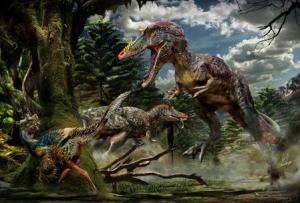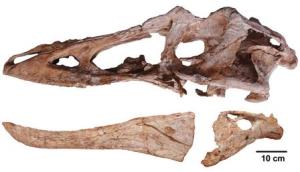By Will Dunham
WASHINGTON (Reuters) - Its nickname may sound
funny - "Pinocchio rex" - but it probably would not have been wise to
laugh at this strange, long-snouted cousin of the famous meat-eating
dinosaur T. rex as it easily could have eaten you alive.
Scientists on Wednesday identified a new member of Tyrannosaurus rex's family, a beast named Qianzhousaurus sinensis that was up to 30 feet (9 meters) long and stalked China at the very end of the age of dinosaurs.
It differs in some significant ways from other members of the carnivorous group of dinosaurs known as tyrannosaurs, especially with a skull far more elongated than that of T. rex.
"It's a new breed of tyrannosaur, with a long snout and lots of horns on its skull, very different from the short-snouted, robust, muscular skulls of T. rex. So it tells us that tyrannosaurs were more ecologically variable than we previously thought," said paleontologist Steve Brusatte of the University of Edinburgh in Scotland, one of the researchers.
Its elongated snout prompted researchers to nickname it "Pinocchio rex," inspired by the wooden puppet who dreamed of being a real boy but whose nose grew when he told a lie. "The long snout made us think of Pinocchio and his long nose, so Pinocchio rex seemed like a cheeky nickname," Brusatte said.
Two other tyrannosaur fossils with long snouts have been found previously in Mongolia but both specimens were juveniles. Brusatte said it had been unclear whether those two were dinosaur kiddies with juvenile features like a long snout that would disappear in adulthood.
"The new fossil solves this debate because it is twice the size of the two Mongolian specimens and much more mature, and still has the long snout and weird horns. So these were not juvenile features, but characteristic features of this unusual subgroup of long-snouted tyrannosaurs," Brusatte said.
Qianzhousaurus lived about 66 million years ago, not long before an asteroid believed to have been 6 miles wide (10 km) hit Earth and wiped out the dinosaurs and many other creatures.
"It would have been one of the last surviving dinosaurs and this species may have even witnessed the asteroid impact," said Brusatte, whose study appears in the journal Nature Communications.
Qianzhousaurus was smaller than T. rex, which lived at the same time in North America, measured about 40 feet (12 meters) long and was the largest known land predator ever. Even though it still had the "toothy grin" of T. rex, the unique snout of Qianzhousaurus and its more slender build suggested it favored different types of prey than "conventional" tyrannosaurs, the researchers said.
"It was still a big boy," Brusatte said. "And it still had a long mouthful of sharp teeth. You wouldn't want to run into it. It is something of a runt compared to T. rex, but T. rex was the baddest predator of all time."
The beautifully preserved fossil was found by workmen at a construction site in Jiangxi province in southern China.
Qianzhousaurus lived in a fairly wet, lush, rich landscape full of dinosaurs including feathered, bird-like ones named Banji, Ganzhousaurus, Jiangxisaurus and Nankangia that may have been on its menu as well as the huge, long-necked Gannansaurus.
"Although we are only starting to learn about them, the long-snouted tyrannosaurs were apparently one of the main groups of predatory dinosaurs in Asia," another of the researchers, paleontologist Junchang Lü of the Chinese Academy of Geological Sciences, said in a statement.
Its genus name, Qianzhousaurus, honors a nearby city. Its species name, sinensis, pays homage to China.
(Reporting by Will Dunham; Editing by James Dalgleish)
Scientists on Wednesday identified a new member of Tyrannosaurus rex's family, a beast named Qianzhousaurus sinensis that was up to 30 feet (9 meters) long and stalked China at the very end of the age of dinosaurs.
It differs in some significant ways from other members of the carnivorous group of dinosaurs known as tyrannosaurs, especially with a skull far more elongated than that of T. rex.
"It's a new breed of tyrannosaur, with a long snout and lots of horns on its skull, very different from the short-snouted, robust, muscular skulls of T. rex. So it tells us that tyrannosaurs were more ecologically variable than we previously thought," said paleontologist Steve Brusatte of the University of Edinburgh in Scotland, one of the researchers.
Its elongated snout prompted researchers to nickname it "Pinocchio rex," inspired by the wooden puppet who dreamed of being a real boy but whose nose grew when he told a lie. "The long snout made us think of Pinocchio and his long nose, so Pinocchio rex seemed like a cheeky nickname," Brusatte said.
Two other tyrannosaur fossils with long snouts have been found previously in Mongolia but both specimens were juveniles. Brusatte said it had been unclear whether those two were dinosaur kiddies with juvenile features like a long snout that would disappear in adulthood.
"The new fossil solves this debate because it is twice the size of the two Mongolian specimens and much more mature, and still has the long snout and weird horns. So these were not juvenile features, but characteristic features of this unusual subgroup of long-snouted tyrannosaurs," Brusatte said.
Qianzhousaurus lived about 66 million years ago, not long before an asteroid believed to have been 6 miles wide (10 km) hit Earth and wiped out the dinosaurs and many other creatures.
"It would have been one of the last surviving dinosaurs and this species may have even witnessed the asteroid impact," said Brusatte, whose study appears in the journal Nature Communications.
Qianzhousaurus was smaller than T. rex, which lived at the same time in North America, measured about 40 feet (12 meters) long and was the largest known land predator ever. Even though it still had the "toothy grin" of T. rex, the unique snout of Qianzhousaurus and its more slender build suggested it favored different types of prey than "conventional" tyrannosaurs, the researchers said.
"It was still a big boy," Brusatte said. "And it still had a long mouthful of sharp teeth. You wouldn't want to run into it. It is something of a runt compared to T. rex, but T. rex was the baddest predator of all time."
The beautifully preserved fossil was found by workmen at a construction site in Jiangxi province in southern China.
Qianzhousaurus lived in a fairly wet, lush, rich landscape full of dinosaurs including feathered, bird-like ones named Banji, Ganzhousaurus, Jiangxisaurus and Nankangia that may have been on its menu as well as the huge, long-necked Gannansaurus.
"Although we are only starting to learn about them, the long-snouted tyrannosaurs were apparently one of the main groups of predatory dinosaurs in Asia," another of the researchers, paleontologist Junchang Lü of the Chinese Academy of Geological Sciences, said in a statement.
Its genus name, Qianzhousaurus, honors a nearby city. Its species name, sinensis, pays homage to China.
(Reporting by Will Dunham; Editing by James Dalgleish)




No comments:
Post a Comment